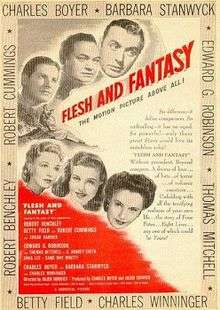Flesh and Fantasy
| Flesh and Fantasy | |
|---|---|
 | |
| Directed by | Julien Duvivier |
| Written by |
Ellis St. Joseph (Story segment 1) Oscar Wilde (Story segment 2) László Vadnay (Story segment 3) Ernest Pascal Samuel Hoffenstein |
| Starring |
Edward G. Robinson Charles Boyer Barbara Stanwyck Betty Field |
| Music by | Alexandre Tansman |
| Cinematography |
Stanley Cortez Paul Ivano |
| Edited by | Arthur Hilton |
| Distributed by | Universal Pictures |
Release dates |
|
Running time | 94 minutes |
| Country | United States |
| Language | English |
| Box office | $1.8 million (US rentals)[1] |
Flesh and Fantasy is a 1943 American anthology film directed by Julien Duvivier, starring Edward G. Robinson, Charles Boyer, Robert Cummings, and Barbara Stanwyck. The making of this film was inspired by the success of Duvivier's previous anthology film, the 1942 Tales of Manhattan. Flesh and Fantasy tells three stories, unrelated but with a supernatural theme, by Ellis St. Joseph, Oscar Wilde, and László Vadnay. Tying together the three segments is a conversation about the occult between two clubmen, one played by humorist Robert Benchley.
Plot
First segment The setting is New Orleans. Plain and embittered Henrietta (Betty Field) secretly loves law student Michael (Robert Cummings). On Mardi Gras night, a mysterious stranger (Edgar Barrier) gives her a white mask of beauty that she must return at midnight. At a party, Michael falls in love with Henrietta but has yet to see her face under the mask. Henrietta encourages Michael to follow a better life although it may mean losing him forever. Henrietta removes the mask at midnight discovering she is now beautiful and that her old, selfish attitude was really the cause of her ugliness.
Second segment The second story is based on Oscar Wilde's short story Lord Arthur Savile's Crime. A palmist named Podgers (Thomas Mitchell) is making uncannily accurate predictions at a party for the rich and bored. He tells skeptical lawyer Marshall Tyler (Edward G. Robinson) to avoid a certain street intersection on the way home. The palmist also acts as if he sees more in his hand but does not admit it. Tyler eschews the advice and almost gets shot during a police chase at the intersection. Tyler goes to the palmist’s home. Under pressure, the palmist admits that he saw that Tyler is going to kill someone.
The notion obsesses Tyler, who decides that he must kill someone, anyone, just to get it over with. He comes close to killing two people but is unable to do so. He finally meets Podgers by accident on a bridge one night, and blaming Podgers for his problem, strangles him to death in a rage. Trying to escape, Tyler is hit by a car. The accident is witnessed by the Great Gaspar (Charles Boyer), a high-wire artist, and it leads without pause into the third segment of the film.
Third segment High-wire artist the Great Gaspar is haunted by dreams of falling, and in each dream of doom encounters a woman (Barbara Stanwyck) he has never met. These dreams affect his performance as he backs down from the most dangerous stunt, jumping from one wire to another. Eventually he meets his dream girl, who has serious troubles of her own. Gaspar later decides that he will not let his bad dreams affect him and that his life is his own. He performs the stunt successfully, not knowing that the woman that he has now fallen in love with is about to be arrested.
Deleted segment
As originally filmed and edited, the feature began with a half-hour sequence concerning an escaped killer (Alan Curtis) who finds refuge with a farmer (Frank Craven) and his blind daughter (Gloria Jean). This sequence ended with a spectacular storm scene, staged by director Duvivier and photographer Paul Ivano, in which the enraged killer races after the blind girl. The forces of nature spare the girl but strike down the killer. The preview audience raved about this scene, but Universal removed it and shelved it. (The very end of the deleted scene survives in the final print: the killer's body washes up on shore.)[2] To replace the missing footage the studio connected the remaining three segments with new footage of humorist Robert Benchley.
Not wanting to waste the Jean-Curtis footage Universal hired screenwriter Roy Chanslor to come up with additional material and Reginald LeBorg to direct a few new scenes, so that the segment could be released as a separate feature film. The studio insisted upon "framing" scenes wherein the refugee is shown to be innocent of the crimes for which he has been imprisoned, and which allowed a happy ending. The completed film was finally released in 1944 as Destiny.[2]
Cast

- Edward G. Robinson as Marshall Tyler
- Charles Boyer as Paul Gaspar
- Barbara Stanwyck as Joan Stanley
- Betty Field as Henrietta
- Robert Cummings as Michael
- Thomas Mitchell as Septimus Podgers
- Charles Winninger as King Lamarr
- Robert Benchley as Doakes
- C. Aubrey Smith as the Dean of Norwald
- Edgar Barrier as the Proprietor of the Mask Shop
References
- ↑ "Top Grossers of the Season", Variety, 5 January 1944 p 54
- 1 2 Tom Weaver, Michael Brunas and John Brunas. Universal Horrors: The Studios Classic Films, 1931-1946, 2007. Jefferson, NC: Mcfarland & Co Inc. ISBN 978-0786429745, pp. 463-468.
External links
- Flesh and Fantasy at the American Film Institute Catalog
- Flesh and Fantasy at the Internet Movie Database